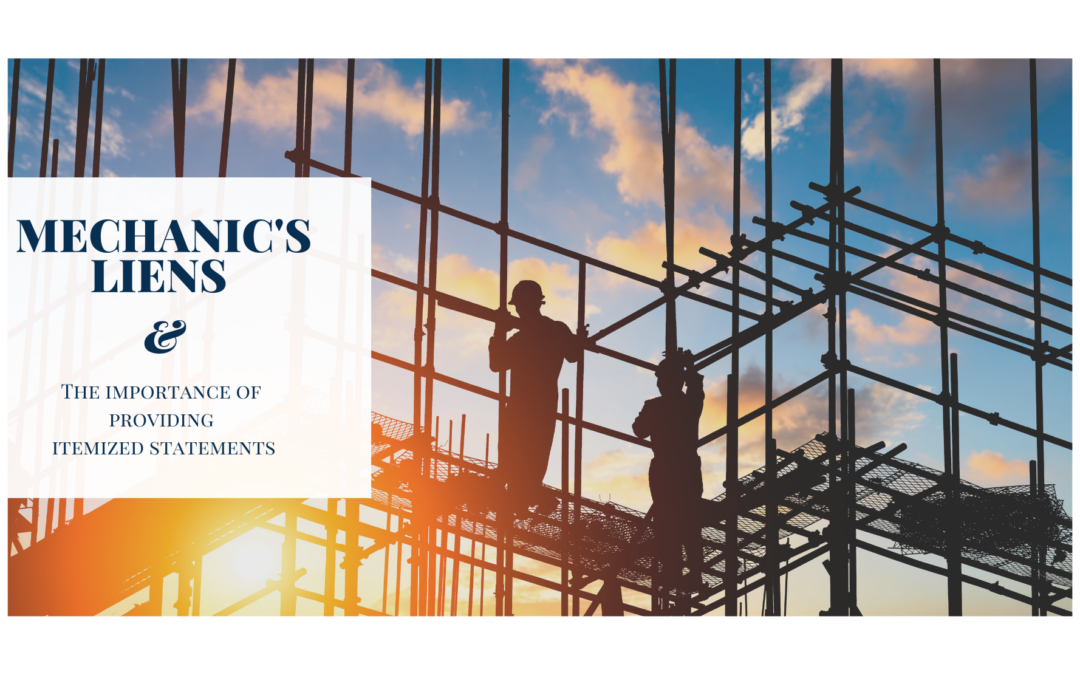A mechanic’s lien is a valuable tool for contractors, subcontractors, and suppliers to secure payment for work performed on a construction project. A mechanic’s lien becomes a powerful tool on a construction project because oftentimes banks issue construction loans in portions or tranches. For example, bank provides one tranche upon completion of the foundation, another tranche upon building of the superstructure, and so forth. In the event that there is a mechanic’s lien filed between the tranches, a bank would not issue any more payments on the loan until the mechanic’s lien is cleared.
What is an Itemized Statement?
An itemized statement is a detailed list of the work performed and the materials supplied, along with the corresponding charges for each item. In New York, the itemized statement must be provided to the property owner 5 days after a property owner makes a demand for an itemized statement.
Why is an Itemized Statement Important?
An itemized statement is important because it provides evidence of the work performed and the materials supplied. This information is necessary to determine the validity of the mechanic’s lien and the amount owed to the contractor, subcontractor, or supplier.
Quite often, a construction project owner has no idea what the lien is for. The first time a construction project owner receives the lien is the first time that owner knows there is an issue with payment to someone on the construction team. Because a construction project generally does not have a direct relationship with a subcontractor or a material supplier, an itemized statement allows the construction owner to get a little more information on the lien
Without an itemized statement, the property owner may challenge the mechanic’s lien and the court may be unable to determine the amount owed. In this scenario, an owner can demand an itemized statement from the person who filed a lien under New York Lien Law 38.
Failure to Provide an Itemized Statement
If a contractor, subcontractor, or supplier fails to provide an itemized statement within 5 days after demand is made, the owner can file a special proceeding with the New York Supreme Court and ask the court to either force the lienor to supply a proper itemized statement or face the possibility of the lien being discharged and no longer having any force or effect.
What is a Proper Itemized Statement?
According to New York Lien Law 38, a proper itemized statement “set[s] forth the items of labor and/or material and the value thereof which make up the amounts for which he claims a lien, and which shall also set forth the terms of the contract under which such items were furnished.”
Trial courts interpret the purpose of the itemization is to apprise the owner of the details of the lienor’s claim. 2269 First Ave Owner LLC v. BDM Sols. LLC, 2019 N.Y. Slip Op. 31823 (N.Y. Sup. Ct. 2019).
The lienor has to produce an adequate itemized statement. As one Court interpreted the requirement, merely providing copies of invoices and lumping together statements, do not meet the requirement of the New York Lien Law 38.
Conclusion
A mechanic’s lien is a valuable tool for contractors, subcontractors, and suppliers to secure payment for work performed on a construction project. However, in order for a mechanic’s lien to be valid, the contractor, subcontractor, or supplier must provide an itemized statement within 5 days after the work has been completed or the materials have been supplied. Failure to provide an itemized statement may result in the discharge of the mechanic’s lien. Property owners should be aware of the requirements for discharging a mechanic’s lien based on failure to provide an itemized statement, and contractors, subcontractors, and suppliers should be aware of the importance of providing an itemized statement in a timely manner.

